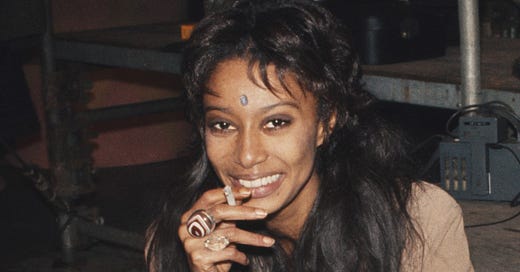(Rolls Press)
For my first muse of 2025, I decided to go with someone who is an influential figure in various mediums. Before Jourdan Dunn, before Tyra Banks, before Naomi Campbell and before Iman, there was Donyale Luna. Just like most figures in the fashion world consider Jean Shrimpton and Twiggy the first white supermodels, Donyale was the very first black supermodel at the same time in the mid/late 1960s. The first black woman to be featured on the cover of Vogue Magazine in March 1966, which also makes her the first black woman to appear on the cover of a major publication. She also tried her hand at acting and was heavily connected to many famous men. Though fascinating and influential to modeling, you might be surprised not many people outside of fashionistas and the like recognize Donyale’s name or face. While there is some of the usual whitewashing from the time and place she was from, a lot of it is actually because of Donyale herself. A self-imposed mysterious and aloof figure, Donyale was born Peggy Ann Freeman to a working class family in Detroit, MI, in 1945 and is said to have had a rather overactive imagination as a child. With her penchant for elaborate, made-up stories and alter-egos, it’s no surprise the striking, tall lady was originally interested in the theater before crossing over to fashion. Despite being American, Donyale’s career success was primarily abroad. First in New York City, then London, then Paris, then finally Rome. Much like another black American legend, actress Josephine Baker, Ms. Luna felt more comfortable living in Europe rather than in middle America pre-civil rights. She also chose to escape a turbulent home life with tempestuous parents by creating new identities and constantly moving.
While there aren’t many video interviews with Donyale, the few out there feature the model speaking with an affected, vaguely European sounding accent whenever she was on camera or around the press. Donyale also popularized wearing blue contacts to contrast her dark features decades before Naomi Campbell would. Although it’s hard to tell which of Donyale’s tales are embellished and which are mainly factual, it sounds like she found it easier to work amongst foreigners than back home. Which is interesting to me, since I remember in a 2022 podcast interview with model Pattie Boyd, Twiggy talked about how the stigma against models was worse in the UK than the US in her experience.
(Fred Mott)
Whatever the case, Donyale had no problem skyrocketing to fame once she hit NYC and London in 1964-65, and was in demand by legendary photographers like David Bailey, Andy Warhol and Helmut Newton; appreciated by designers such as Mary Quant, Paco Rabanne and Yves Saint Laurent; posed alongside modeling peers like Audrey Hepburn, Jill Kennington and Kellie Wilson; appeared in various catwalks, zines, ads and record sleeves; and befriended by most of the then relevant stars. Though she was living the high life in Swingin’ London and the camera loved her unique and memorable features, Donyale did worry about becoming the token non-white model in the industry and didn’t want to be pigeonholed as just ‘exotic’ publicly. With how extreme the socialite went to exaggerate her looks and roots, it’s hard to tell if she was seeking out independence in an unusual way; or if she had some deep seeded issues similar to old Hollywood star Merle Oberon, where she wasn’t comfortable with her own skin and didn’t want it to affect her success.
Wearing colored contacts, coming up with fake accents, claiming one day to be of Egyptian descent, and then the next to be Polynesian. Saying the civil rights movement is a good idea, but that she “doesn’t want to get involved” with it. All of it just sounds like a lot of compensating for the fact that Donyale was an ordinary black girl from Detroit. I sympathize with anyone who has experienced racial prejudice and it’s too bad she didn’t grow up in a more loving household. Add this to her tragic death at 33 in 1979 from a drug overdose, and it really sounds like a shame. By fighting so hard not to be a public face of her people she almost ended up erasing her legacy from the historical canon in a way. Yet even with all this said, Donyale still lived an interesting and full, albeit short, life. Her attempts at a side acting career didn’t pan out much, but she still got to work with respected filmmakers Otto Preminger and Federico Fellini on the films Skidoo (1968) and Satyricon (1969); and can be seen in Michael Lindsay-Hogg’s concert film The Rolling Stones’ Rock & Roll Circus (1968). She was raised Presbyterian, but converted to Catholicism in her late teens. Her significant others included Oscar winning actor Maximilian Schell, character actor Klaus Kinski, rock musician Brian Jones, photographer Richard Avedon, artist Martin Sharp, and her eventual widower, photographer Luigi Cazzaniga; who was also the father of her one child, daughter Dream [b. 1978]. Dream was sadly only 18 months old when her mother died, but has been her biggest supporter in keeping her legacy alive all these years later. This includes an official documentary, Nailah Jefferson’s Donyale Luna: Supermodel (2023), where her life and legacy are delved into by admirers like Beverly Johnson and Pat Cleveland, and close associates such as Dream, Luigi and David Bailey. Donyale was a unique and important figure in pop culture history. It’s just unfortunate her story isn’t more complete.






